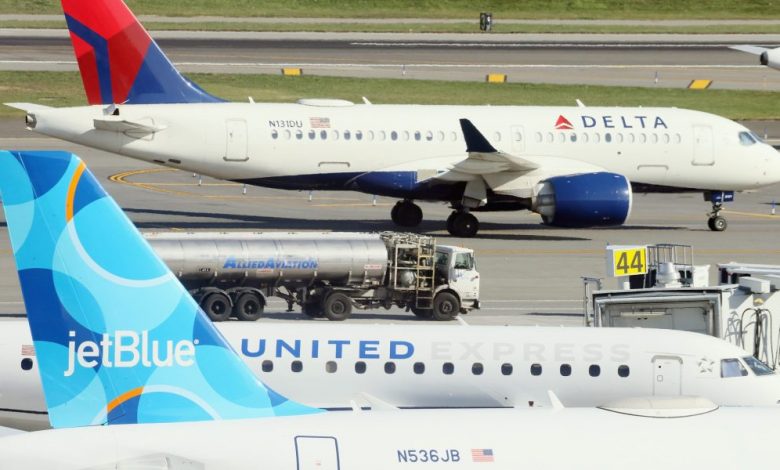The increase in dangerous incidents affecting airlines is raising safety concerns

Federal officials have begun investigating a close connection between planes in Boston, and they released new details Thursday about a harrowing incident at a Texas airport.
The National Transportation Safety Board said it didn’t determine exactly how close a FedEx cargo plane flew over the top of a Southwest Airlines jet in Austin, Texas last month, but there was little margin.
“We still believe the planes were less than 100 feet apart,” NTSB Chairwoman Jennifer Homendy said in an interview.
An air traffic controller cleared both planes to use the same runway, the NTSB said in a preliminary report. With visibility down to a quarter mile due to freezing fog, FedEx pilots were only able to see the Southwest jet in the last few seconds.
The NTSB is also investigating an incident Monday night at Boston’s Logan International Airport in which a Learjet pilot, who was instructed by an air traffic controller to wait instead, began taking off when a JetBlue plane approached to board an intersecting plane to land runway. The JetBlue pilots stopped and avoided a collision.
These and similar incidents in New York, California and Hawaii prompted the head of the Federal Aviation Administration to call a “safety summit,” sparking debate over whether flight safety is declining or if the events are just an unusual cluster of serious near misses .
“I don’t know if I can say it’s a trend, but these are troubling because it only takes one,” Homendy said. “That’s why we investigate incidents – so we can spot problems, particularly when we spot trends, and address them before they become a full-blown accident.”
Among the other recent incidents now under investigation:
– Last week, pilots of a small airliner aborted their landing in Burbank, California, after a controller cleared another plane to take off from the same runway; The NTSB determined.
— A United Airlines jet crossed a runway at Honolulu International Airport in front of a Cessna cargo plane which landed on the same runway on January 23.
– The NTSB took the rare step of issuing subpoenas for pilots of an American Airlines plane that traversed a runway used by a Delta Air Lines jet to take off Jan. 13 at John F. Kennedy International Airport in New York . The American pilots initially refused to sit down for taped interviews, but they agreed after receiving subpoenas, Homendy said.
– Federal officials take another look at an incident in which a United Airlines jet taking off from Hawaii dove to within 800 feet of the ocean before recovering. According to United, the pilots of the December flight will receive additional training.
With the exception of the United plane, which crashed badly after takeoff, the other incidents were “runway incursions,” where a plane landed on a runway when it wasn’t supposed to be there. A 2017 forum convened by the NTSB found that the most common causes of runway robberies were pilots ignoring orders from air traffic controllers or miscommunication between pilots and controllers.
“Runway incursions have always been an area of concern, but things are looking worse because the system is so secure,” said John Hansman, an aviation professor at the Massachusetts Institute of Technology. “Fortunately, we don’t have many accidents, so we’re focusing on those risk precursors.”
Pilots are the last line of defense in flight safety. In some recent incidents – notably in Austin – pilots spotted an error and responded quickly.
The incidents could put an end to any opportunity to relax experience requirements for newly hired pilots, which smaller, regional airlines have called for to help them deal with a pilot shortage. President Joe Biden’s nominee for the FAA’s top job, Phillip Washington, said Wednesday he was opposed to relaxing pilot qualification standards.
The tight outlook could also lead to calls for improved technology at airports and on board planes. Kennedy Airport has a ground surveillance radar designed to prevent runway intrusion. It alerted air traffic controllers that the American Airlines plane was crossing an active runway. Only 35 US airports have this technology.
Investigators will not be able to hear what the pilots were doing prior to most of the recent incidents because the cockpit voice recordings were erased after two hours of flight. Since 2018, the NTSB has asked the FAA to require 25 hours of recording capacity, which would improve the chances of storing valuable information.
In addition to the near misses, there have also been several recent incidents of severe turbulence resulting in injuries on aircraft. In the most recent case, a Lufthansa plane flying from Austin to Germany was diverted to Washington Dulles International Airport on Wednesday evening; seven people on board were injured so badly that they had to be taken to hospital. The FAA said they are checking.
The terse calls have caught the attention of lawmakers, who questioned the acting FAA administrator about them. The official, Billy Nolen, last month defended the security of the nation’s air travel system while acknowledging the need for vigilance.
“We are witnessing the safest time in aviation history, but we don’t take that for granted,” Nolen told a Senate committee. “Recent events are a reminder that we must not become complacent.”
Nolen, along with airline industry executives, points out that there hasn’t been a fatal crash involving a US airline plane since 2009, an unprecedented stretch.
Still, he said at the hearing and in an internal memo he was forming a “safety review team” to examine the aviation system, beginning with a meeting in March, “to consider what additional actions the aviation community needs to take to keep our safety record.” .” Nolen said aviation leaders will review which steps are working “and why others don’t seem as effective as they used to be.”
The FAA said Thursday the summit will be held on March 15 and will include representatives from commercial aviation, airports, labor and aviation experts.
Learn how to navigate and build trust in your organization with The Trust Factor, a weekly newsletter exploring what leaders need to succeed. Login here.



